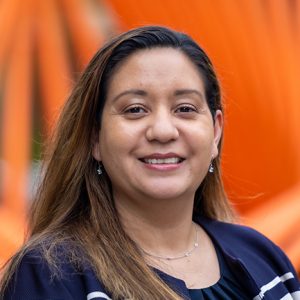Essie Torres is the first director of inclusive and equitable research and workforce strategy within the Office of the Vice Chancellor for Research.
On May 9, Essie Torres joined the Office of the Vice Chancellor for Research as its first-ever director of inclusive and equitable research and workforce strategy. She comes to Carolina from East Carolina University, where she worked as a professor in the Department of Health Education and Promotion.
In this new role, she will oversee OVCR’s commitment to a diverse and welcoming research community that upholds the highest standards of inclusive excellence. She will also develop a coordinated strategy for expanding community partnerships, diversifying human subjects research programs, and recruiting and investing in faculty, trainees, students, and research staff that better reflect a culturally diverse intellectual community.
UNC Research recently spoke with Torres about this new role and her plans for collaborating with stakeholders across campus to develop research opportunities that advance inclusivity.
Tell us a little bit about yourself and how you came to work on diversity, equity, and inclusion programs.
I am a health equity researcher with over 20 years of experience in public health, specifically working to empower and improve the quality of life for underserved communities. The intersection of my lived experiences and research have contributed to my passion and work in Diversity, Equity, and Inclusion (DEI). This includes addressing social determinants of health that impact the health of our underserved communities, building research capacity among community partners, creating pipeline training opportunities for BIPOC students, and working to create equitable and inclusive environments for faculty, staff, and students.
You’ve been with the OVCR for a little over a month now. What have you observed that is already working well?
As I complete my first month on the job, I realize many units across OVCR have contributed to impactful DEI work and there are several resources that can continue to be supported and expanded upon. I am still developing my understanding of the DEI landscape at UNC-Chapel Hill and will continue to identify efforts, potential collaborations, opportunities for improvement, and resources.
What are some of your initial priorities for enhancing current initiatives and creating new ones that will help us build an equitable and inclusive research environment?
Currently, I am engaging key leaders and stakeholders across OVCR and the university via listening sessions and meetings. My goal is to use information from these sessions and meetings to develop a road map to address identified gaps, needs, and opportunities for building upon current DEI efforts in research. This will include collaborating with units within OVCR and across the university that are active in DEI efforts in diverse spaces within UNC’s research enterprise.
Tell us more about your efforts to improve diversity and representation in clinical trials and research populations.
Efforts to improve diversity across various research populations will require a multi-prong approach that includes continuing to build equitable community partnerships, efforts to diversify the scientific workforce, and system-level changes to policies and research processes that will continue to support inclusive and equitable research practices.
What would a successful DEI program for the OVCR look like in five years?
A successful DEI program for the OVCR would include an integrated and unified approach that effectively supports continued progress in achieving DEI goals within the research enterprise and a community of practice that supports an equitable and inclusive research environment.
